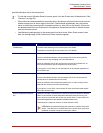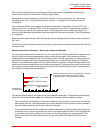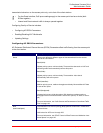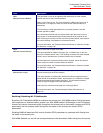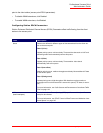
Professional Access Point
Administrator Guide
Quality of Service - 144
IEEE 802.11e task group is in the process of defining a QoS standard for transmission quality and
availability of service on wireless networks. QoS is designed to provide better network service by
minimizing network congestion; limiting Jitter, Latency, and Packet Loss; supporting dedicated bandwidth
for time-sensitive or mission critical applications; and prioritising wireless traffic for channel access.
As with all IEEE 802.11 working group standards, the goal is to provide a standard way of implementing
QoS features so that components from different companies are interoperable.
The Professional Access Point provides QoS based on the Wireless Multimedia (WMM) specification and
Wireless Multimedia (WMM) standards, which are implementations of a subset of 802.11e features.
Both access points and wireless clients can be WMM-enabled.
QoS Queues and Parameters to Coordinate Traffic Flow
Configuring QoS options on the Professional Access Point consists of setting parameters on existing
queues for different types of wireless traffic. You can configure different minimum and maximum wait times
for the transmission of packets in each queue based on the requirements of the media being sent. Queues
automatically provide minimum transmission delay for voice, video, multimedia, and mission-critical
applications and rely on best-effort parameters for traditional IP data.
For example, time-sensitive voice, video, and multimedia are given effectively higher priority for
transmission (lower wait times for channel access), while other applications and traditional IP data—which
are less time-sensitive but often more data-intensive—are expected to tolerate longer wait times.
The Professional Access Point implementation of QoS is based on the IEEE Wireless Multimedia (WMM)
standard. A Linux-based queuing class is used to tag packets and establish multiple queues. The queues
provided offer built-in prioritisation and routing based on the type of data being transmitted.
The Web User Interface provides a way for you to configure parameters on the queues.
QoS Queues and Type of Service (ToS) on Packets
QoS on the Professional Access Point uses WMM information in the IP packet header related to Type of
Service (ToS). Every IP packet sent over the network includes a ToS field in the header that indicates how
the data is to be prioritised and transmitted over the network. The ToS field consists of a 3- to 7-bit value
with each bit representing a different aspect or degree of priority for this data as well as other meta-
information (low delay, high throughput, high reliability, low cost, and so on).
For example, the ToS for FTP data packets is likely to be set for maximum throughput since the critical
consideration for FTP is the ability to transmit bulk data. Interactive feedback is a benefit in this situation
but certainly is less critical than the FTP data itself. VoIP data packets are set for minimum delay because
time is a critical factor in quality and performance for that type of data.
The access point examines the ToS field in the header of each packet that passes through the access
point. Based on the value in a packet’s ToS field, the access point prioritises the packet for transmission by
assigning it to one of the queues. This process occurs automatically, regardless of whether you
deliberately configure QoS or not.
A different type of data is associated with each queue. The queue and associated priorities and
parameters for transmission are as follows:
• Data 0 (Voice). Highest priority queue, minimum delay. Time-sensitive data such as Voice over IP (VoIP)








